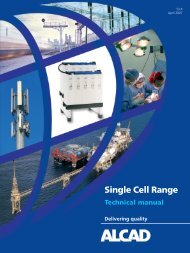Lead Acid Battery Operating Instructions - Alcad.com
Lead Acid Battery Operating Instructions - Alcad.com
Lead Acid Battery Operating Instructions - Alcad.com
You also want an ePaper? Increase the reach of your titles
YUMPU automatically turns print PDFs into web optimized ePapers that Google loves.
The duration of the freshening charge is dependent on the amount of charge to be<br />
restored, the temperature, and the charge voltage utilized. In general, it should not be<br />
necessary to charge for more than 96 hours. The freshening charge should be continued<br />
until the specific gravity readings for all cells have remained constant for at least 2 hours.<br />
7.3 Charging In Service<br />
Most standby power batteries are charged by "float" or modified constant voltage<br />
chargers. The information in these instructions is based on this charging method. Details<br />
of battery operation from other charging sources may be obtained from <strong>Alcad</strong> Standby<br />
Batteries.<br />
Floating battery systems are those where the charger, the battery and the load are<br />
connected in parallel. The charger output voltage is set to a particular value and under<br />
normal conditions the applied charging voltage is maintained within very close limits.<br />
Most float chargers have two adjustable charge voltages: the "equalize" setting (also<br />
known as "boost", "high rate" or "recharge") will restore the battery to a fully charged state<br />
within a relatively short period; the "float" setting will maintain the battery in a high state of<br />
charge with minimal water consumption.<br />
The float voltage may be set between 2.15 and 2.25 volts per cell. The re<strong>com</strong>mended set-<br />
is 2.23 volts per cell, which will maintain the battery in a fully charged state without the<br />
need for periodic equalize charges. Float voltages above 2.23 volts per cell should be<br />
avoided if the operating temperature frequently exceeds 80°F (27°C).<br />
For float voltages below 2.23 volts per cell, periodic equalize charges should be given in<br />
accordance with the following table:<br />
Float Voltage<br />
(per cell)<br />
2.23 Never<br />
-6-<br />
Equalizing Required<br />
at these Intervals<br />
2.20 Every 6 Months<br />
2.17 Every 3 Months<br />
2.15 Every Month<br />
Equalizing is generally required when the total voltage spread between the cells is greater than<br />
0.04 V under float charging conditions.<br />
Charging at the equalize setting is necessary for fast recharging after an<br />
emergency discharge. A short equalize charge is also desirable after addition<br />
of distilled water to assist in mixing the acid and water (see Section 9.3).<br />
Equalizing may be carried out at voltage settings above 2.30 volts per cell. The<br />
maximum equalize voltage is generally determined by the maximum voltage<br />
which the system can tolerate. Normal values of equalize voltage are around<br />
2.33-2.35 volts per cell.<br />
The battery should not be subjected to a final charge current, during the<br />
gassing state, of greater than the finishing rate shown in Section 11. This<br />
current corresponds to a charge voltage of approximately 2.7 volts per cell.<br />
The length of equalize charging required will depend on the depth of discharge,<br />
electrolyte temperature and normal float voltage level. The best guideline is to<br />
continue equalizing until the specific gravity of the acid in the pilot cell (see<br />
Section 9.4) has been constant for at least 2 hours.



